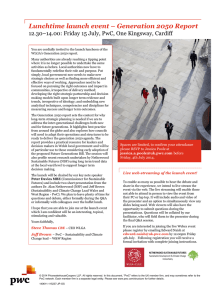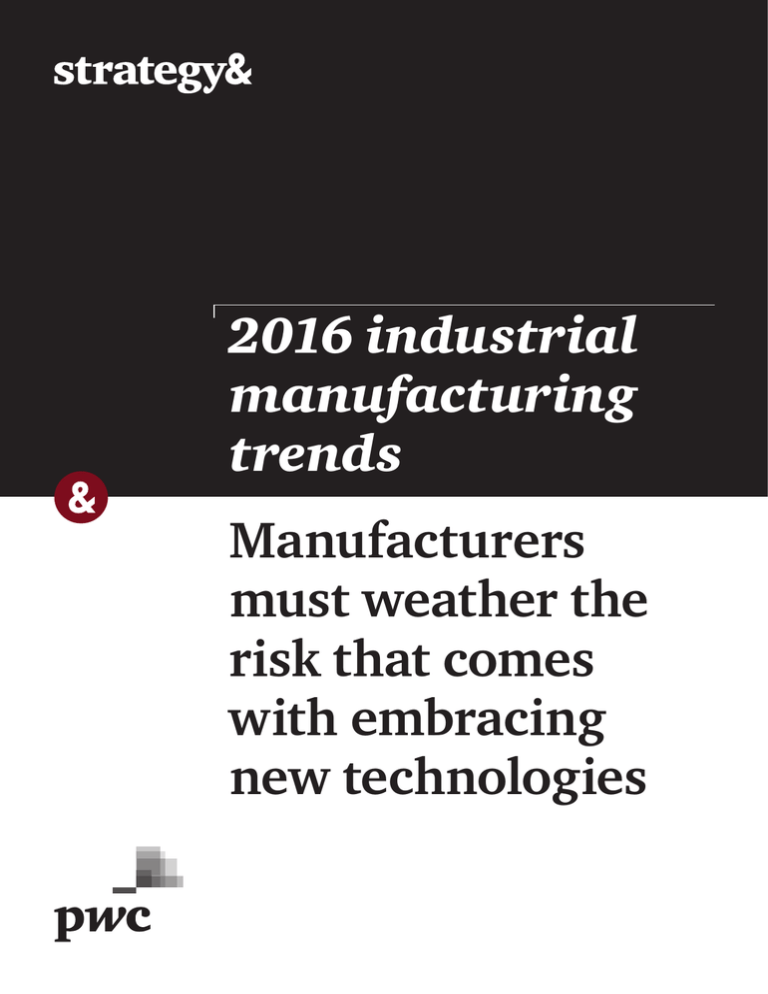
2016 industrial
manufacturing
trends
Manufacturers
must weather the
risk that comes
with embracing
new technologies
Contacts
Beirut
Florham Park
London
Fadi Majdalani
Partner, PwC Middle East
+961-1-985-655
fadi.majdalani
@strategyand.ae.pwc.com
Barry Jaruzelski
Principal, PwC US
+1-973-410-7624
barry.jaruzelski
@strategyand.us.pwc.com
John Potter
Partner, PwC UK
+44-207-212-5390
john.potter
@strategyand.uk.pwc.com
Charlotte
Marian Mueller
Principal, PwC US
+1-973-410-7659
marian.mueller
@strategyand.us.pwc.com
Tokyo
Robert Bono
Partner, PwC US
+1-704-350-7993
robert.b.bono@pwc.com
Frankfurt
Chicago
Steve Pillsbury
Principal, PwC US
+1-312-298-2257
steve.pillsbury@pwc.com
2
Kiyoshi Okamoto
Partner, PwC Japan
+81-3-6250-1200
kiyoshi.okamoto
@strategyand.jp.pwc.com
Dr. Richard Viereckl
Partner, PwC Germany
+49-69-97167-0
richard.viereckl
@strategyand.de.pwc.com
Strategy&
About the authors
Robert Bono is a PwC partner based in Charlotte and leader of the PwC
United States Industrial Manufacturing Practice. He has served a
variety of clients, from international, publicly traded companies to
emerging, development-stage companies.
Stephen Pillsbury is a principal with PwC’s Automotive, Industrial,
and Aerospace practice, based in Chicago. He has experience consulting
on supply chain and manufacturing operations, business strategy, and
acquisition integration.
Strategy&
3
Introduction
The sting of 2001 and 2008 is still too painful for some industrial
manufacturing companies to forget. Back then, global economic
expansion enticed industrial manufacturers to invest in new equipment
and technologies designed to improve factory performance for
themselves and their customers. When markets unexpectedly crashed,
they paid a steep price for having bought at the top of the cycle. The
payoff took years to realize, if it appeared at all.
This recollection colors the tentative steps that many industrial
manufacturing companies are taking today. Indeed, economic growth,
although occurring, isn’t particularly robust. It’s anybody’s guess
whether China is heading for a soft landing or a renewed takeoff. The
Eurozone’s future and the prospects for Brazil, India, and Russia are
impossible to read. It’s tempting to believe that a boardroom version
of “the prevent defense” — avoiding possible big losses by taking few
chances — may be the best strategy.
But that conclusion is a false choice. Manufacturing may be facing some
headwinds, but it’s undeniably in the midst of a technological
renaissance that is transforming the look, systems, and processes of the
modern factory. Despite the risks — and despite recent history —
industrial manufacturing companies cannot afford to ignore these
advances. By embracing them now, they can improve productivity in
their own plants, compete against rivals, and maintain an edge with
customers who are seeking their own gains from innovation.
Manufacturers
must embrace
technological
advances to
improve plant
productivity,
compete
against rivals,
and maintain
an edge with
customers.
Rather than fearing the past, industrial manufacturing executives
should be asking these critical questions: At a time of rapid change and
limited upside, which technology investments will have the biggest
positive impact on my business? And what is the value potential, return
on investment, and risk of investing in these technologies?
4
Strategy&
Technological transformation
Given today’s leading-edge capabilities, it’s reasonable to envision —
and prepare for — a data-driven factory of the future where all internal
and external activities are connected through the same information
platform. Customers, designers, and operators will share information
on everything from initial concepts, to installation, to performance
feedback throughout the life cycle. Operators will access materials on
demand, collaborate with robots to use them safely and ergonomically,
and rely on virtual work instructions presented at the point of use.
Assembly lines will output highly personalized products, sometimes
in a lot size of one, that contain zero defects.
But what breakthrough equipment, ideas, and processes will have
the greatest impact on factory environments? The following four
technology categories are already driving much of the change.
• Internet of Things (IoT): The connected factory is an idea that
has been evolving for the past few years. Increasingly, it means
expanding the power of the Web to link machines, sensors,
computers, and humans in order to enable new levels of information
monitoring, collection, processing, and analysis. These devices
provide more precision and can translate collected data into insights
that, for example, help to determine the amount of voltage used to
produce a product or to better understand how temperature,
pressure, and humidity impact performance. Stanley Black & Decker
has adapted the Internet of Things in a plant in Mexico to monitor
the status of production lines in real time via mobile devices and
Wi-Fi RFID tags. As a result, overall equipment effectiveness has
increased by 24 percent, labor utilization by 10 percent, and
throughput by 10 percent.
But for industrial manufacturing companies, the next generation
of IoT technology should go well beyond real-time monitoring to
connected information platforms that leverage data and advanced
analytics to deliver higher-quality, more durable, and more reliable
products. A hint of this can be seen in wind turbines manufactured
by General Electric. This equipment contains some 20,000 sensors
Strategy&
5
that produce 400 data points per second. Immediate, ongoing
analysis of this data allows GE and its customers to optimize
turbine performance and proactively make decisions about
maintenance and parts replacement.
Before investing in IoT, however, industrial manufacturing
companies must determine precisely what data is most valuable
to collect, as well as gauge the efficacy of the analytical structures
that will be used to assess the data. In addition, next-generation
equipment will require a next-generation mix of workers, which
should include employees who can design and build IoT products
as well as data scientists who can analyze output.
• Robotics: Over the last decade, China emerged as an automated
manufacturing powerhouse, as increased labor costs and booming
industrial demand drove tremendous growth in industrial robotics.
Since 2013, the number of shipments of multipurpose industrial
robots in China roughly doubled to an estimated 75,000 in 2015,
with that number forecast to double yet again to 150,000 by 2018,
according to the International Federation of Robotics. Yet although
a Chinese company recently broke ground on the world’s first fully
automated factory, in Dongguan, the widespread use of robotics and
unmanned control technologies may not address all productivity
concerns. Indeed, some manufacturers believe that greater
automation is harmful, resulting in less innovation because only
people can develop ideas to improve processes and products.
Consequently, robotic implementation is evolving on a different
path in the U.S. and other mature economies. In many cases, robots
are employed to complement rather than replace workers. This
concept, known as “cobotics,” teams operators and machines in
order to make complex parts of the assembly process faster, easier,
and safer.
Cobotics is rapidly gaining momentum, and successful
implementations to date have focused largely on specific
ergonomically challenging tasks within the aerospace
and automotive industries. But these applications will
expand as automation developers introduce more sophisticated
sensors and more adaptable, highly functional robotic
equipment that will let humans and machines interact deftly
on the factory floor.
• Augmented reality: Recent advances in computer vision,
computer science, information technology, and engineering
have enabled manufacturers to deliver real-time information
and guidance at the point of use. Users simply follow the text,
graphics, audio, and other virtual enhancements superimposed
6
Strategy&
onto goggles or real assemblies as they perform complex tasks on the
factory floor. These tools can simultaneously assess the accuracy and
timing of these tasks, and notify the operator of quality risks.
Some industrial manufacturing companies are using this
technology to provide hands-free training, enable faster responses
to maintenance requests, track inventory, increase safety, and
provide a real-time view of manufacturing operations. In more
than a few instances, these added services could be sold as add-ons
to the equipment itself, creating a new revenue stream for industrial
manufacturing firms. Among the possible applications is an
assembly-line instructional feature in which video clips or text
instructions walk workers through complex processes step-by-step.
Mistakes resulting from fatigue or on-the-job pressure are
eliminated. Another possibility involves using data and physical
evidence retrieved by augmented reality on the factory floor to
design new equipment that addresses the shortcomings of presentday devices on the assembly line.
• 3D printing: Also known as additive manufacturing, 3D printing
technology produces solid objects from digital designs by building
up multiple layers of plastic, resin, or other materials in a precisely
determined shape. Early adopters among industrial manufacturing
companies are using 3D printing to manufacture parts in small lots
for product prototypes, to reduce design-to-manufacturing cycle
times, and to dramatically alter the economics of production. For
example, BAE Systems turned to 3D printing when it could no
longer secure a critical injection-molded plastic part for a regional
jetliner. The company saved more than 60 percent on the cost of
the part, avoided retooling costs, and shrank production lead
times by two months.
Industrial
manufacturers
should apply
3D printing
technology
to product
development and
prototyping to
spur innovation
and reduce timeto-market.
3D printing is still in its infancy, and the technology is currently
limited in the performance specifications of the products it can
produce. But companies must begin planning for the incorporation of
this technology now. As an initial step, industrial manufacturing
companies should apply 3D printing technology to the product
development and prototyping process, where its speed and flexibility
can spur innovation and reduce time-to-market. The next step could
be to use 3D printing to make highly specialized, low-volume parts
that are components or subassemblies of finished products, or to
create tools for the molding, casting, or forming of products.
Strategy&
7
New risk and reward equation
In our view, industrial manufacturing executives should consider
investments in emerging technologies through three paths of analysis:
1. Determine the specific areas to improve in your organization,
or what performance target a technology investment is trying
to achieve. How will the investment impact cost, quality, labor,
or other strategic concerns? How will the new technology help
differentiate the value you provide to customers? Will it create
capacity or generate productivity in the constrained parts of your
operations? Will the technology provide increased flexibility to
help you deal with uncertainty?
2. Understand how the new technologies will enable that level
of performance — and weigh the value of achieving that
performance against the cost of the technology. What level
of output should the facility be able to create today, and how much
improvement can be expected over time as the technology continues
to evolve? Who are the current industry leaders in each technology
category, and what tangible impact is their technology having?
What is the clock speed of the technology, and how feasible is it
that it will evolve to reliably deliver on the performance goals?
3. Understand the operational and organizational implications of
the technology and how it aligns with the factory of the future
vision. How does it help or hurt operators or the culture? How should
teaming and incentives models evolve to optimize new technology?
How scalable is the technology? How well does it integrate into a
company’s technology backbone and global footprint?
Although the emerging technologies are potentially transformative,
they are unfolding against a backdrop of uncertainty among
industrial manufacturing companies. In the fourth-quarter 2015
PwC Manufacturing Barometer™, which surveys U.S.-based industrial
manufacturing executives, only 27 percent of industrial manufacturing
CEOs expressed optimism about the global economy. Industrial
manufacturers’ estimated mean revenue growth, moreover, declined
8
Strategy&
to 1.8 percent in 2015, from 5.2 percent in the prior year, according
to this report. Worse yet, just 31 percent of companies are operating
near full capacity in the fourth quarter, a decline of 26 percentage
points in the past 12 months.
Still, this data should be viewed as the springboard for calculated
action. Rapid factory innovation is altering the risk/reward equation.
A timid response to seemingly tepid economic conditions can quickly
place businesses in jeopardy — behind competitors and unable to
address customer needs — even as markets improve in the coming
years. We’ve found that making strategic investments is essential
for growth, particularly in fast-evolving industries. Given that
manufacturing technology is evolving faster than ever before, many
of the technologies being introduced today will be commonplace within
five or 10 years. Industrial products executives must lead with an eye
toward that reality, and not merely the current bottom line.
Pessimism among industrial manufacturing CEOs…
Percent optimistic about U.S. economy for next 12 months
76%
69%
60%
46%
1Q
2015
2Q
2015
3Q
2015
4Q
2015
Source: Copyright © PwC
Manufacturing Barometer™
report
Strategy&
9
Is reflected in fewer new strategic alliances…
Plans for strategic alliances in the next 12 months
29%
20%
17%
13%
1Q
2015
2Q
2015
3Q
2015
4Q
2015
Source: Copyright © PwC
Manufacturing Barometer™
report
10
Strategy&
And stagnant spending on information technology.
Percent planning to increase IT spending in next 12 months
36%
33%
1Q
2015
22%
22%
2Q
2015
3Q
2015
4Q
2015
Source: Copyright © PwC
Manufacturing Barometer™
report
Strategy&
11
Strategy& is a global team
of practical strategists
committed to helping you
seize essential advantage.
We do that by working
alongside you to solve your
toughest problems and
helping you capture your
greatest opportunities.
These are complex and
high-stakes undertakings
— often game-changing
transformations. We bring
100 years of strategy
consulting experience
and the unrivaled industry
and functional capabilities
of the PwC network to the
task. Whether you’re
charting your corporate
strategy, transforming a
function or business unit, or
building critical capabilities,
we’ll help you create the
value you’re looking for
with speed, confidence,
and impact.
We are part of the PwC
network of firms in 157
countries with more than
208,000 people committed
to delivering quality in
assurance, tax, and advisory
services. Tell us what
matters to you and find out
more by visiting us at
strategyand.pwc.com.
www.strategyand.pwc.com
© 2016 PwC. All rights reserved. PwC refers to the PwC network and/or one or more of its member firms, each of which is a separate legal entity. Please see www.pwc.com/structure for further
details. Mentions of Strategy& refer to the global team of practical strategists that is integrated within the PwC network of firms. For more about Strategy&, see www.strategyand.pwc.com.
No reproduction is permitted in whole or part without written permission of PwC. Disclaimer: This content is for general purposes only, and should not be used as a substitute for consultation
with professional advisors.



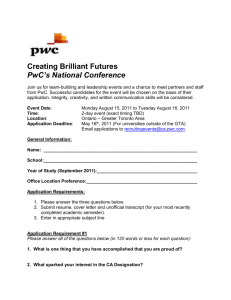
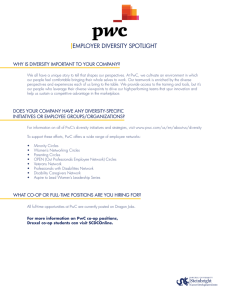

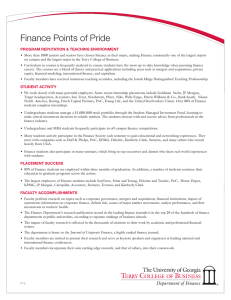
![(On client's letterhead) [Debtor] – [Address]](http://s2.studylib.net/store/data/015619376_1-634457b7baedfa32fb5e3856cbcd37b7-300x300.png)
